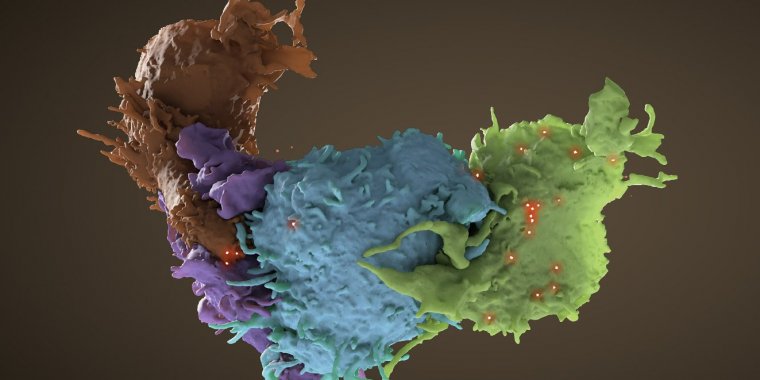| Health / Health News |
HIV can persist for years in myeloid cells of people on antiretroviral therapy
A subset of white blood cells, known as myeloid cells, can harbor HIV in people who have been virally suppressed for years on antiretroviral therapy, according to findings from a small study.

3D structure of HIV infected (blue, green) and uninfected (brown, purple) T cells interacting. One cell (brown) has wrapped an extension around its uninfected neighbor (purple) to reach an infected cell (blue). Photo: Donald Bliss, National Library of Medicine; Sriram Subramaniam, National Cancer Institute, National Institutes of Health
In the study, researchers used a new quantitative method to show that HIV in specific myeloid cells—short-lived monocytes and longer-lived monocyte-derived macrophages—can be reactivated and infect new cells.
The findings suggest that myeloid cells contribute to a long-lived HIV reservoir, making these cells an important but overlooked target in efforts to eradicate HIV.
“Our findings challenge the prevailing narrative that monocytes are too short-lived to be important in cure efforts,” said study author Rebecca Veenhuis, Ph.D., an assistant professor of molecular and comparative pathobiology and of neurology at Johns Hopkins University School of Medicine, Baltimore.
“Yes, the cells are short-lived, but our follow-up data show that HIV can persist in monocytes over several years in people who are virally suppressed. The fact that we can detect HIV in these cells over such a long period suggests something is keeping the myeloid reservoir going.”
Antiretroviral medications are effective in treating HIV because they prevent the virus from infecting new cells and multiplying.
However, HIV may still exist in cells that are in a resting, or latent, state, creating an HIV reservoir. CD4 T cells, a type of white blood cell, are the most well-studied HIV reservoir. Identifying HIV reservoirs is critical to cure efforts, as latent HIV can be reactivated if people stop taking antiretroviral medications.
Monocytes are immune cells that circulate in the blood for about 3 days before traveling to tissue in various parts of the body, including the brain, where they can mature into macrophages.
To date, it has not been clear whether latent HIV in these cells can become active again and infect other cells.
“What’s really important in the long run is understanding how monocytes contribute to the tissue macrophage reservoir,” explained Janice Clements, Ph.D., senior author on the study and professor of molecular and comparative pathobiology at Johns Hopkins University School of Medicine.
“If monocytes can carry virus to the brain, or lung, or another part of the body and infect resident macrophages that are self-renewing and live almost indefinitely, that’s a real problem.”
In the study, Veenhuis, Clements, and colleagues first measured HIV DNA in myeloid cells in a sample of 30 participants with HIV, all of whom were virally suppressed and had been on antiretroviral therapy for at least 5 years.
They found detectable levels of HIV genetic material in monocytes and macrophages, though the levels were much lower than those observed in CD4 T cells.
In some participants, the HIV genetic material found in monocytes was intact, which suggests it may be capable of infecting other cells if reactivated.
The researchers isolated monocytes from blood samples taken from 10 participants and nurtured the monocytes in cultures that contained antiretroviral drugs, to replicate the participants’ baseline physical state.
After the monocytes differentiated into macrophages, the researchers introduced an immune activating agent and then added fresh white bloods cells to allow for the virus to spread to new cells.
The researchers collected samples from the cell cultures several times over the next 12 days. They included checkpoints throughout the process to ensure that infected CD4 T cells did not interfere with their measurements.
The results showed that cultures from five of the 10 participants had detectable HIV genetic material in monocyte-derived macrophages that could be reactivated to infect other cells and produce more virus.
The participants who had these reactivatable reservoirs of HIV in monocyte-derived macrophages had higher overall levels of HIV DNA material.
Follow-up data from three participants showed that this reservoir can be long-lived, harboring latent HIV for months to several years.
These reservoirs were stable and could be reactivated over time, indicating that monocyte-derived macrophages could contribute to viral rebound if antiretroviral treatment is disrupted. (National Institutes of Health)
YOU MAY ALSO LIKE





